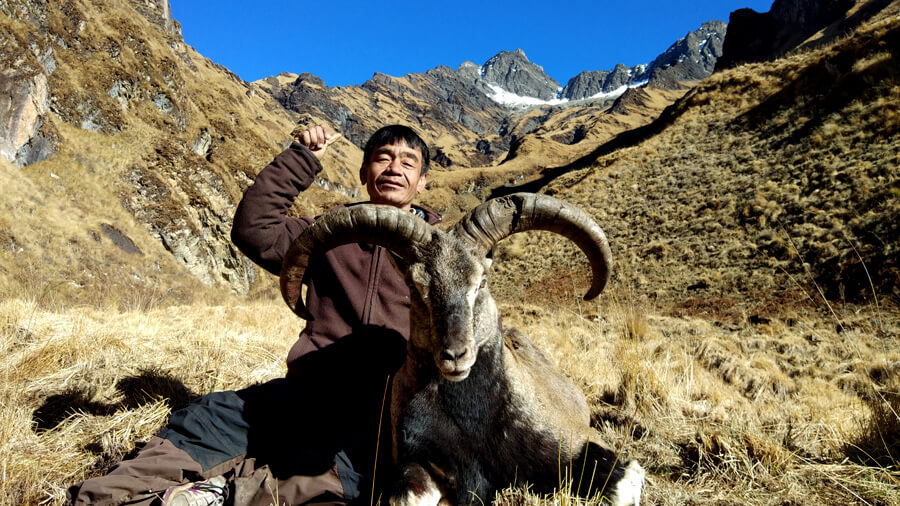Blue Sheep and Himalayan Tahr are the main species of Hunting in Nepal. It is found at elevations above 4000 meters in the Dhorpatan Hunting Reserve. We have described the nature of these two animals. The info will support you to experience the nature of animals.
Table of Contents
BLUE SHEEP: Goats with Sheep-like Traits
Scientific Name: Pseudois Nayaur
Body Structure
Blue sheep, or also known as Naur, Bharal, is a caprine native to the high Himalayas. Regardless of its name, neither it is blue nor sheep. Blue sheep are more closely related to a goat than to a sheep. Their body frame is medium in size. The head to the body usually is 115 cm to 165 cm long, and the tail is 10 cm to 20 cm long. Likewise, the body mass ranges from 35 kg to 75 kg.
The male blue sheep are slightly bigger than the females. Their coat is slate gray to pale brown with a bluish sheen. If you talk more about the physiology of blue sheep, their underparts and back of the legs are white. The front of the legs and the chest is black. Blue sheep's ears are small, and the bridge of the nose is dark with horns on both sexes.
The horns of males are grown upwards, turn sideways & curve backward with a length of around 80 cm. In females, the horns are straighter and shorter, with a length of up to 20 cm.
Behavior
Blue sheep show a combination of goat and sheep-like behavior. They live in groups. Blue sheep prefer to stay on steep slopes and rocky cliffs. To escape from predators, blue sheep generally live on hillsides with grasses, which help them a lot to hide. They rarely go beyond 200 meters from rocky terrain.
Habitat
You'll find blue sheep on treeless slopes, shrub zone, and alpine meadows. They are highly tolerant of environmental extremes. Sometimes may be seen in hot and dry regions to windy, cold, and snowy terrains from 1,200 m/3,900 ft to 5,300 m/17,400 ft.
Blue sheep are spread across the Tibetan Plateau and neighboring mountain ranges. In the upper part of Tibet, Nepal, India, Pakistan, and Bhutan are found. In some parts of China's Gansu, Yunnan, Sichuan, Xinjiang, and Ningxia provinces, blue sheep are seen.
Eating Habits
The Blue Sheep eats herbs, grasses, lichens, and mosses.
HIMALAYAN TAHR: A Wild Goat of Mountains
Scientific Name: Hemitrogus Jemlahicus
Body Structure
Himalayan Tahr is a wild goat of mountains. It is one of the three species of tahr. The other two are the Arabian tahr of Oman and the Nilgiri of southern India. The males are usually larger than the females. Their weight ranges from 79 to 198 pounds.
Himalayan tahr has a small head with pointed ears, big eyes, and horns. Their horns have a maximum length of 46 cm and are sexually dimorphic. Again the female tahrs are smaller in size and have less weight with short horns. Their horns are curved backward, which prevents injury during mating season. The head butting is a common mating ritual among male tahrs.
The weight of the male is 73 kg on average, and the female is 36 kg on average. As found in the Himalayas, the outer body parts of the tahr are well adapted to the harsh cold climate. They have thick, reddish wool coats with dense undercoats. As the winter ends, the coats of tahr become thin and lighter in color because of shedding.
Himalayan Tahr is an ungulate group of members and has an even number of toes. They have a unique ability to grasp both smooth and rough surfaces of the mountain terrain. Their hooves are like rubber, perfect for gripping smooth, and the keratin at the rim of their hooves increases the hoof durability. It helps tahr to mobilize on rocky grounds.
The Himalayan tahr lifespan typically ranges from 14 to 15 years. The female lives longer than males. As per records, the oldest Himalayan tahr lived for 22 years old in captivity.
Behavior
Himalayan tahr lives in herds that can include up to 80 members. They are mostly active in the early morning and late afternoon. Most of the time, they spend grazing and browsing on leaves. They climb to a higher altitude in the daytime and descend to a lower elevation at night to have better access to food & water. This also helps them to avoid predators.
Habitat
Himalayan tahrs are the native of the Himalayas. They are introduced to countries like Argentina, New Zealand, South Africa, and the United States. They are found at high altitudes from 2,500 m/8,202 ft to 5,000 m/16,404 ft in Nepal's Himalayas.
Eating Habits
Himalayan tahr are herbivores. They eat shrubs, grasses, trees, and some fruits.




